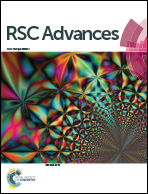Enhancement of the near-infrared emission of Ce3+–Yb3+ co-doped Y3Al5O12 phosphors by doping Bi3+ ions
Abstract
Ce3+–Yb3+ co-doped Y3Al5O12 phosphors are one of most the potential candidates of down-conversion materials for photovoltaic cells. To improve the near-infrared emission from Yb3+ ions, Bi3+ ions were introduced into the phosphors. The experimental results showed that the intensity of Yb3+ emission was greatly enhanced after doping Bi3+ ions into the phosphors. This may be attributed to an additional pathway via Bi3+ ions for the energy transfer from Ce3+ to Yb3+. Different from the co-doped phosphors, where the energy of Ce3+ ions was transferred only to Yb3+ ions, in Bi3+–Ce3+–Yb3+ tri-doped phosphors, the energy of Ce3+ ions could be transferred not only to Yb3+ ions but also to Bi3+ ions. Then, Bi3+ ions transferred part of the energy to Yb3+ ions. This enabled Yb3+ ions to obtain more energy and enhance their near-infrared emission.



 Please wait while we load your content...
Please wait while we load your content...